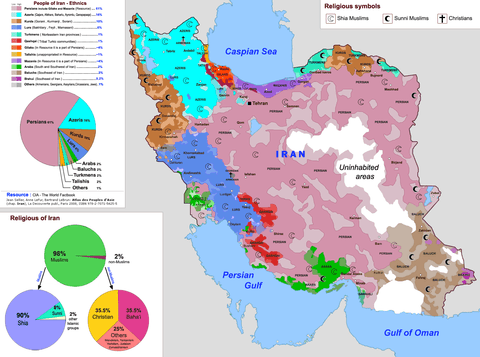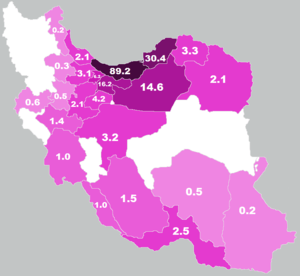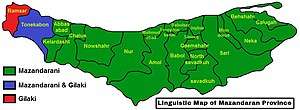Mazanderani people
The Mazanderani people (Mazanderani: مازرون) or Tabari people (Mazanderani: تپورون) are an Iranian people[3][4][5] who are indigenous to the Caspian region of Iran. They inhabit the sea's south coast and are part of the historical region known as Tabaristan. The Alborz mountains mark the southern boundary of Mazanderani people's settlement.[6][7]
| Total population | |
|---|---|
| 3 million[1] to 4 million[2] (2006) | |
| Regions with significant populations | |
| Province of Mazandaran and parts of the provinces of Alborz, Golestan, Tehran and Semnan in Iran | |
| Languages | |
| Mazanderani | |
| Religion | |
| Mostly Shi'a Muslim | |
| Related ethnic groups | |
| Iranian peoples, Caucasian peoples |
People

The Mazanderani number between three[1] and four million (2006 estimate).[2] Their dominant religion is Shiite Islam.[8]
Most Mazanderanis live on the southeastern coast of the Caspian Sea. Their traditional professions are farming and fishing.[1] The Mazanderanis are closely related to the neighbouring Gilaki people as well as Caucasian peoples (e.g., the Georgians, Armenians, and Azerbaijanis).[1][9][10]
Language

The Mazanderani language is a Northwestern Iranian language spoken by the Mazanderani people; however, most Mazanderanis are also fluent in Persian.[6][8] The Gilaki and Mazanderani languages (but not other Iranian languages) share certain typological features with Caucasian languages.
With the growth of education and the media, the distinction between Mazanderani and other Iranian languages is likely to disappear.[6][8] Mazanderani is closely related to Gilaki and the two languages have similar vocabularies.[6] They preserve more of the noun declension system characteristic of older Iranian languages than Persian does.[6]
Assistant professor Maryam Borjian of Rutgers University states that Mazanderani has different sub-dialects and there is high mutual intelligibility among Mazanderani sub-dialects.[8]
Genetics

The Mazanderani and the closely related Gilaks occupy the south Caspian region of Iran and speak languages belonging to the North-Western branch of Iranian languages. It has been suggested that their ancestors came from the Caucasus region, perhaps displacing an earlier group in the South Caspian.[11] Linguistic evidence supports this scenario, in that the Gilaki and Mazanderani languages (but not other Iranian languages) share certain typological features with Caucasian languages.
Based on mtDNA HV1 sequences, the Gilaki and Mazanderani most closely resemble their geographic and linguistic neighbors, namely other Iranian groups. However, their Y chromosome types most closely resemble those found in groups from the South Caucasus.[11] Researchers explained these differences that males from the Caucasus settled in the south Caspian area, mated with women from local Iranian groups, possibly because of patrilocality.[11] The Mazanderani and Gilaki groups are closely related on the male side with populations from the South Caucasus such as Georgians, Armenians, and Azerbaijani's.[11]
Haplogroups
Analysis of their NRY patrilines has revealed haplogroup J2, associated with the neolithic diffusion of agriculturalists from the Near East, to be the predominant Y-DNA lineage among the Mazanderani (subclades J2a3h-M530, J2a3b-M67 and J2a-M410, more specifically.).[12] The next most frequently occurring lineage, R1a1a, believed to have been associated with early Iranian expansion into Central/Southern Eurasia and currently ubiquitous in that area, is found in almost 25%,. This haplogroup, with the aforementioned J2, accounts for over 50% of the entire sample.[12][13] Haplogroup G2a3b, attaining significant frequency together with G2a and G1, is the most commonly carried marker in the G group among Mazanderani men. The lineages E1b1b1a1a-M34 and C5-M356 comprise the remainder, of less than 10% sampled.[12]
Notable figures
Historic
- Abu Jafar Muhammad ibn Jarir ibn Yazid ibn Kathir al-Tabari (838–923) was a Mazanderani historian and theologian (the most famous and widely influential person called al-Tabari).
- Abu Jafar Muhammad ibn Jarir ibn Rustom al-Tabari was a Shia thinker who is commonly confused with the former. He is the author of the book Dala'il al-Imamah (Proofs of the Imamate)
- Ali ibn Sahl Rabban al-Tabari, "Ali the scholar from Tabiristan" (838–870 A.D.), was the writer of a medical encyclopedia and the teacher of the scholar physician Zakariya al-Razi.
- Abul Hasan al-Tabari, a 10th-century Iranian physician
- Al-Tabarani (c. 821–918 CE), author of numerous ahadeeth
- Amir Pazevari, poet
- Maziar, Iranian aristocrat of the House of Karen
Contemporary
- Reza Shah, emperor of Iran (Persia) from 1924 to 1941
- Nima Yooshij, poet, 1941
- Mina Assadi, poet
- Emamali Habibi, Olympic and world champion of free-style wrestling/Babr e Mazandaran
- Ali Larijani, former member of the Supreme National Security Council of Iran and Speaker of the Majlis of Iran
- Mohammad Javad Larijani, mathematician and former member of the Majlis
- Sadegh Larijani, head of the judiciary of the Islamic Republic of Iran
- Mohammad Zohari, poet
- Mohsen Bengar, footballer
- Delkash, singer
- Ahmad Mohsenpour, musician
- Ali Pahlavan, singer
- Gholam-Hossein Banan, singer
- Ehsan Tabari, Marxist theoretician
- Noureddin Kianouri, politician
- Parinaz Izadyar, Actress
- Parviz Natel-Khanlari, writer/translator
- Habibollah Badiei, musician
- Reza Allamehzadeh, director
- Rashid Mostaghim, singer
- Behdad Salimikordasiabi, Olympic weightlifter
- Mohammad Donyavi, musician
- Emad Ram, musician
Assimilated populations in Mazandaran
In the Safavid, Afsharid, and Qajar eras Mazandaran was settled by large amounts of Georgians, Circassians, Armenians and other peoples of the Caucasus, whose descendants still live across Mazandaran.[14][15][16] Many towns, villages and neighbourhoods in Mazandaran bear the name "Gorji" (i.e., Georgian) in them, although most of the Georgians are assimilated into the mainstream Mazanderanis: they keep a Georgian conscience. The history of Georgian settlement is described by Iskandar Beg Munshi, the author of the 17th century History of Alam Aray Abbasi. In addition foreigners, e.g., Chardin and Della Valle, have written about their encounters with the Georgian, Circassian and Armenian Mazanderanis.[16]
See also
- Caspian people
- Māzandarān Province
- Peoples of the Caucasus
- Iranian peoples
- List of famous people from Mazandaran
- Mazanderani language
- Tapurian dance
References
- Middle East Patterns: Places, Peoples, and Politics By Colbert C. Held, John Cummings, Mildred McDonald Held,2005, page 119.
- Iran Provinces
- Area handbook for Iran, Harvey Henry Smith, American University (Washington, D.C.), Foreign Area Studies, page 89
- Academic American Encyclopedia By Grolier Incorporated, page 294
- The World Book Encyclopedia, World Book, Inc, 2000, page 401
- Dalb, Andrew (1998). Dictionary of Languages: The Definitive Reference to More Than 400 Languages. Columbia University Press. p. 226. ISBN 978-0-231-11568-1.
- Ethnologue report for language code:mzn
- in Mazandaran: Peaceful Coexistence With Persian, Maryam Borjian, Columbia University, page 66.
- Nasidze, Ivan; Quinque, Dominique; Rahmani, Manijeh; Alemohamad, Seyed Ali; Stoneking, Mark (2006). "Concomitant Replacement of Language and mtDNA in South Caspian Populations of Iran". Current Biology. 16 (7): 668–673. doi:10.1016/j.cub.2006.02.021. PMID 16581511.
- Iran, Encarta Encyclopedia Iran. Archived 2009-10-28 at the Wayback Machine 2009-10-31.
- Nasidze, Ivan; Quinque, Dominique; Rahmani, Manijeh; Alemohamad, Seyed Ali; Stoneking, Mark (2006). "Concomitant Replacement of Language and mtDNA in South Caspian Populations of Iran". Current Biology. 16 (7): 668–673. doi:10.1016/j.cub.2006.02.021. PMID 16581511.
- Grugni, V; Battaglia, V; Hooshiar Kashani, B; Parolo, S; Al-Zahery, N; et al. (2012). "Ancient Migratory Events in the Middle East: New Clues from the Y-Chromosome Variation of Modern Iranians". PLoS ONE. 7 (7): e41252. doi:10.1371/journal.pone.0041252. PMC 3399854. PMID 22815981.
- R. Spencer Wells et al., "The Eurasian Heartland: A continental perspective on Y-chromosome diversity," Proceedings of the National Academy of Sciences of the United States of America (August 28, 2001)
- "Georgian communities in Persia". Retrieved 17 April 2014.
- ^ Muliani, S. (2001) Jaygah-e Gorjiha dar Tarikh va Farhang va Tammadon-e Iran. (The Georgians’ position in the Iranian history and civilization.) Esfahan: Yekta
- Brentjes, Sonja; Schüller, Volkmar (2006). "PIETRO DELLA VALLE'S LATIN GEOGRAPHY OFSAFAVID IRAN (1624-1628)". Journal of Early Modern History. 10 (3): 169–219. doi:10.1163/157006506778234162. Retrieved 17 April 2014.